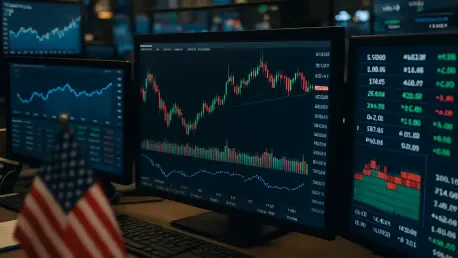On a pivotal day for U.S. financial markets, November 11 witnessed a striking divergence as the Dow Jones Industrial Average surged over 500 points to an unprecedented record close, while the Nasdaq Composite faltered under the burden of a struggling technology sector. This remarkable split in market performance captivated investors globally, encapsulating a blend of optimism, caution, and sector-specific challenges. The Dow’s impressive climb to 47,927.96, marking a 1.2% gain, reflected strong confidence in a potential resolution to a historic 41-day government shutdown, hinting at forthcoming economic clarity. Meanwhile, the Nasdaq’s 0.2% decline, heavily influenced by a significant drop in Nvidia’s stock value, spotlighted growing doubts about the durability of the AI-driven tech boom. The S&P 500, navigating between these extremes, managed a modest 0.2% uptick, balancing tech losses with gains in other areas. This day’s market activity was far more than a set of numbers; it told a deeper story of shifting investor priorities, where traditional sectors gained favor amid tech uncertainty. What forces propelled the Dow to such heights while the Nasdaq stumbled? The answers lie in a complex mix of political developments, corporate earnings, consumer trends, and geopolitical undercurrents. This intricate landscape raises critical questions about future market directions and offers a glimpse into the challenges and opportunities shaping investment decisions.
Market Dynamics: Contrasting Fortunes of Major Indices
The Dow Jones Industrial Average delivered a standout performance with a 559.33-point leap to a record close of 47,927.96, achieving a 1.2% increase on November 11. This surge was underpinned by a wave of investor optimism surrounding a potential end to the prolonged government shutdown. Comprising a broad mix of industries such as finance, energy, and consumer goods, the Dow’s structure—with only about 20% exposure to technology compared to over 50% for the Nasdaq—positioned it as a relative safe haven during tech sector turbulence. Sectors like industrials and financials, heavily weighted in the Dow, likely benefited from expectations of economic transparency once delayed data becomes available. This rally underscored a flight to stability, as investors sought refuge in traditional sectors less swayed by the volatility impacting tech-heavy indices. The Dow’s ascent was not just a numerical achievement but a signal of broader confidence in the resilience of diversified, established industries amid uncertainty elsewhere in the market.
In stark contrast, the Nasdaq Composite experienced a 0.2% decline, dragged down primarily by significant losses in technology stocks, with Nvidia’s drop serving as a focal point. As an index dominated by tech giants and growth-oriented companies, the Nasdaq has reaped substantial gains from the AI rally throughout the year, but this heavy reliance also amplifies its vulnerability to sector-specific downturns. The S&P 500, often viewed as a balanced benchmark, posted a slight 0.2% gain, reflecting a mix of tech losses offset by strength in areas like energy and healthcare. This divergence among the major indices highlights a pivotal shift in investor sentiment, where confidence in non-tech sectors buoyed the Dow, while skepticism about technology’s near-term prospects weighed on the Nasdaq. Such contrasting fortunes illustrate the nuanced interplay of sector dynamics driving overall market behavior on this notable day.
Tech Sector Struggles: Nvidia’s Decline and AI Concerns
Nvidia, a cornerstone of the AI chipmaking industry, became the epicenter of the Nasdaq’s challenges as its stock value fell by approximately 2.5-3% on November 11. This decline was sparked by SoftBank Group’s unexpected decision to divest its entire $5.8 billion stake in the company, redirecting those resources to fund its own AI initiatives. Such a move by a major tech investor raised immediate concerns about Nvidia’s long-standing dominance in the AI hardware space, sending a ripple of uncertainty through the market. Beyond the immediate financial impact, this divestiture suggested a potential shift in industry confidence, prompting questions about whether other major stakeholders might follow suit. The sell-off wasn’t merely a reaction to one event but a reflection of deeper apprehensions about the tech sector’s current trajectory, particularly in areas where growth expectations have been exceptionally high.
Further compounding Nvidia’s difficulties were troubling updates from associated firms, intensifying fears of an AI bubble. CoreWeave, an AI infrastructure provider supported by Nvidia, cut its revenue forecast for the coming year, resulting in a 15% drop in its own stock price. Additionally, Taiwan Semiconductor Manufacturing Company (TSMC), a critical supplier for Nvidia, reported its slowest monthly revenue growth in recent times, citing currency fluctuations and softening demand. These developments fueled investor skepticism about the sustainability of massive capital investments in AI infrastructure, especially as valuations in the sector remain elevated. The ripple effect touched related semiconductor companies like Arm Holdings, Micron, and Advanced Micro Devices, which also saw declines. This collective downturn suggests a broader reassessment of the AI-driven rally, raising the question of whether the sector’s explosive growth might be approaching a critical turning point.
Political Developments: Hope for Shutdown Resolution
A significant catalyst for the Dow’s record-breaking performance was the burgeoning optimism surrounding a potential resolution to the 41-day U.S. government shutdown, one of the longest in recent history. Late on November 10, the Senate advanced a funding measure, paving the way for a possible House vote in the following days. This progress ignited hope among investors, who anticipated that an end to the shutdown would release a backlog of critical economic data, including figures on GDP growth, inflation, and employment. Such data is vital for gauging the Federal Reserve’s future moves on interest rates, a key determinant of market sentiment. The prospect of renewed clarity drove bullish behavior, particularly in indices like the Dow, which are less tied to tech volatility and more reflective of broader economic health. This political development was a beacon of potential stability, influencing investor decisions across various sectors.
However, the optimism was tempered by practical challenges even if the shutdown concludes swiftly. Analysts have pointed out that the processing and release of delayed economic data could take weeks, prolonging the current state of uncertainty. In the absence of official figures, markets have relied on private data sources, such as ADP’s recent report indicating 11,250 weekly job cuts in October, suggesting a slowdown in the labor market. This reliance on fragmented information complicates assessments of economic conditions and Fed policy direction. While the Senate’s action provided a much-needed boost to market confidence, the lingering data vacuum serves as a reminder of the shutdown’s far-reaching impact. The situation underscores how political gridlock can directly affect financial markets, creating both opportunities for gains and hurdles to sustained momentum in indices like the Dow.
Sectoral Performances: Bright Spots and Challenges
Amid the broader market dynamics, certain sectors and companies stood out with notable performances that added depth to the day’s narrative. FedEx emerged as a highlight, with its stock appreciating by 5% following a positive forecast of improved quarterly profits. This announcement, shared during an investor conference, alleviated concerns about the critical holiday season, a period when logistics companies face intense pressure to perform. The optimism surrounding FedEx also signaled underlying strength in consumer spending, a crucial economic driver, especially as other sectors grapple with uncertainty. This uptick in a logistics giant’s outlook provided a counterbalance to the tech sector’s woes, illustrating how varied industries can experience divergent fortunes even on a single trading day. It also reflected investor confidence in operational resilience amid broader economic and political challenges.
Elsewhere, the electric vehicle sector saw a boost with Rivian’s stock rising 5%, part of a remarkable 38% gain over five trading days. This surge was driven by quarterly revenue figures that exceeded Wall Street expectations, showcasing robust demand and operational success in a competitive market. Rivian’s performance offered a stark contrast to struggles in other areas, highlighting the growth potential within sustainable transportation despite economic headwinds. Conversely, airline stocks faced downward pressure, with companies like Delta, American, United, and Southwest declining by 1-2% due to ongoing flight disruptions linked to the government shutdown. Recent reports of over 20,000 flight delays or cancellations underscored persistent operational challenges, dampening revenue prospects. These contrasting sectoral stories reveal the uneven impact of macroeconomic conditions, where some industries thrive while others navigate significant obstacles.
Consumer Behavior: Indicators of Economic Pressure
Shifting consumer behavior provided subtle yet telling insights into underlying economic challenges on November 11. At fast-casual dining chains like Chipotle, declining sales and the emergence of a so-called “bowl crisis indicator”—where customers receive noticeably smaller portions as a cost-saving measure—pointed to financial strain, particularly among younger demographics. This trend reflects broader pressures such as rising housing costs, a stagnant job market, and slower wage growth, all of which are curbing discretionary spending. For industries reliant on consumer confidence, such signals are concerning, as they suggest a growing wariness about non-essential expenses. This shift in priorities among consumers could have lasting implications for sectors like retail and casual dining, which depend heavily on consistent foot traffic and spending patterns to maintain profitability.
The impact of these economic pressures extends beyond individual companies to influence broader market sentiment. As younger consumers, often a key demographic for growth-oriented businesses, tighten their budgets, the ripple effects are felt across various sectors. This price sensitivity serves as a reminder of the fragile balance within the economy, where even robust performances in certain areas, like logistics or electric vehicles, coexist with signs of strain elsewhere. The “bowl crisis” may seem anecdotal, but it encapsulates a larger narrative of economic challenges that could temper market optimism if not addressed. For investors, understanding these consumer trends is crucial, as they highlight potential vulnerabilities in sectors that might otherwise appear stable, adding a layer of complexity to investment strategies during periods of mixed market performance.
Global Influences: U.S.-China Trade and Commodity Shifts
Geopolitical developments, particularly in U.S.-China trade relations, introduced additional variables into the market equation on November 11. China’s announcement of plans to restrict rare-earth mineral exports specifically to U.S. military applications, while increasing supply to other American buyers, sparked concerns about trade stability. These minerals are essential for technology and defense industries, making this strategic move a potential source of volatility for related sectors. The decision underscored the fragility of current trade dynamics, as any disruption in critical material supply chains could have far-reaching consequences for manufacturing and innovation-driven companies. This development served as a reminder of how international policies can directly impact domestic markets, influencing investor sentiment across multiple industries.
In a parallel geopolitical shift, the opening of the Morebaya port in Guinea marked a significant milestone with the potential to reshape global commodity markets. This port facilitates a major influx of iron ore from the Simandou project, where Chinese companies hold substantial control, potentially reducing China’s dependence on traditional mining giants like Rio Tinto and BHP Group. Such a reconfiguration of supply chains could introduce new competitive pressures and alter pricing dynamics in the iron ore market, affecting related sectors. These geopolitical maneuvers highlight the intricate connection between global trade policies and financial markets, adding a layer of uncertainty for investors already navigating domestic challenges like the government shutdown and tech sector turbulence. The intersection of these international developments with local market trends emphasizes the complexity of the current investment landscape.
Earnings Strength: A Foundation Amid Uncertainty
Despite the mixed signals from various sectors and geopolitical tensions, corporate earnings emerged as a stabilizing force for the broader market on November 11. Recent reports revealed that 82% of S&P 500 companies surpassed profit expectations, achieving a year-over-year earnings growth of 13.1%. This strong performance, highlighted by analysts from institutions like Morgan Stanley, provided a reassuring foundation amid the tech sector’s struggles and political uncertainties. The robust earnings figures suggested that many companies are navigating economic challenges effectively, maintaining profitability even in a complex environment. This resilience was a key factor in supporting overall market confidence, particularly for indices like the Dow, which benefited from strength in non-tech sectors.
Notably, the broadening of earnings growth beyond the realm of Big Tech was a particularly positive development. Sectors such as industrials, consumer goods, and energy contributed significantly to profit gains, indicating a more diversified and sustainable rally. However, market strategists cautioned that sustaining this momentum is critical to preserving investor trust, especially as uncertainties in technology and geopolitics persist. The earnings data offered a counterpoint to the Nasdaq’s tech-driven decline, suggesting that the market’s foundation remains solid in many areas. For investors, this earnings strength provided a measure of reassurance, though the need for continued performance across diverse sectors remains paramount to counterbalance the headwinds facing specific industries and to ensure long-term market stability.
Looking Ahead: Navigating a Complex Market Landscape
Reflecting on the events of November 11, the U.S. stock market revealed a landscape of profound contrasts, where the Dow Jones Industrial Average’s record-breaking climb stood in sharp relief against the Nasdaq Composite’s tech-driven decline. The day encapsulated a pivotal moment of investor sentiment, balancing hope for political resolution with caution over technology’s future. The Dow’s ascent, fueled by expectations of an end to the government shutdown, highlighted the enduring appeal of traditional sectors, while Nvidia’s struggles underscored emerging doubts about the AI rally’s longevity. These dynamics played out against a backdrop of varied sectoral performances, consumer economic pressures, and geopolitical tensions, painting a multifaceted picture of market behavior.
Moving forward, the focus shifted to actionable strategies for navigating this intricate environment. Investors were advised to monitor the progress of the government funding measure closely, as the release of delayed economic data could significantly influence Federal Reserve policy and market direction. Diversification emerged as a critical approach, with a recommendation to balance exposure across tech and non-tech sectors to mitigate risks tied to industry-specific volatility. Keeping an eye on corporate earnings remained essential, as sustained profit growth could continue to anchor market stability. Additionally, staying informed on U.S.-China trade developments was deemed vital, given their potential to disrupt supply chains and commodity markets. This period demanded a nuanced perspective, blending cautious optimism with strategic vigilance to capitalize on opportunities while safeguarding against uncertainties that lingered on the horizon.









